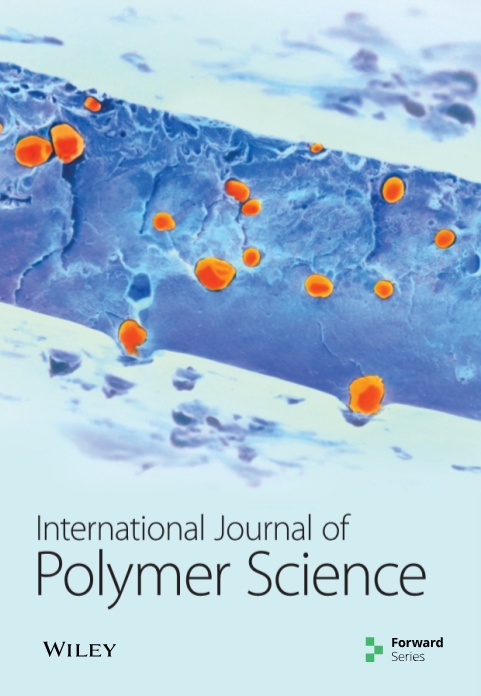Optimized Poly(3-hydroxybutyrate-co-3-hydroxyvalerate) (PHBV) Production by Moderately Haloalkaliphilic Bacterium Halomonas alkalicola Ext
IF 4.4
4区 化学
Q2 POLYMER SCIENCE
引用次数: 0
Abstract
Polyhydroxyalkanoates (PHAs) are biodegradable and biocompatible polymers that are produced by microorganisms as storage materials under limited nutrition and excess carbon. These PHAs have been found to be ideal for replacing synthetic plastics for use in packaging and biomedical applications. In this study, an alkaliphilic and moderately halophilic bacterium Halomonas alkalicola Ext was isolated from Lake Simbi Nyaima in western Kenya and investigated for PHA production. Sudan Black B and Nile Red A staining showed that bacterium had distinct ability for accumulation of PHAs. To optimize PHA production, the bacterium was grown in submerged fermentation under varying culture conditions and different sources and concentrations of carbon and nitrogen. With one-factor-at-a-time (OFTA) approach, optimal PHA yields were obtained after 72 hours at a pH of 10.0, temperature of 35°C, and 2.5% (w/v) NaCl. The bacterium yielded the highest biomass, and PHA amounts on 2% galactose and 0.1% ammonium sulfate as sources of carbon and nitrogen, respectively. A record PHA yield of 0.071 g g-1 with a titer of was achieved from 3.397 g/L of biomass, equivalent to 41.8% PHA content. Using response surface methodology, PHA titer was increased by 1.5% to 1.44 g/L, while PHA content was improved 1.1-fold to 45.57%. Polymer analysis revealed that the extracted PHA was a poly(3-hydroxybutyrate-co-3-hydroxyvalerate) (PHBV) () with two copolymer subunits of 3-hydroxyvaryrate (3-HB) and 3-hydroxybutyrate (3-HV). Halomonas alkalicola Ext attained efficient galactose conversion into PHBV under high salinity and alkalinity conditions.中度嗜卤烷基细菌 Halomonas alkalicola Ext 的聚(3-羟基丁酸-3-羟基戊酸)(PHBV)优化生产技术
聚羟基烷酸酯(PHA)是一种可生物降解且具有生物相容性的聚合物,由微生物在有限的营养和过剩的碳条件下作为储存材料生成。这些 PHAs 被认为是替代合成塑料用于包装和生物医学应用的理想材料。本研究从肯尼亚西部的 Simbi Nyaima 湖中分离出一种嗜碱性和中度嗜卤细菌 Halomonas alkalicola Ext,并对其生产 PHA 的情况进行了调查。苏丹黑 B 和尼罗河红 A 染色显示,该细菌具有积累 PHA 的独特能力。为了优化 PHA 的生产,该细菌在不同的培养条件、不同的碳源和氮源及浓度下进行浸没发酵培养。在 pH 值为 10.0、温度为 35℃、氯化钠含量为 2.5%(w/v)的条件下,采用一次一因素(OFTA)的方法,72 小时后可获得最佳 PHA 产量。在以 2% 半乳糖和 0.1% 硫酸铵分别作为碳源和氮源的条件下,该细菌的生物量和 PHA 产量最高。从 3.397 克/升的生物质中获得了创纪录的 0.071 克/克的 PHA 产量和滴度,相当于 41.8% 的 PHA 含量。利用响应面方法,PHA 滴度提高了 1.5%,达到 1.44 g/L,而 PHA 含量提高了 1.1 倍,达到 45.57%。聚合物分析表明,提取的 PHA 是一种聚(3-羟基丁酸酯-3-羟基戊酸酯)(PHBV),具有 3-羟基戊酸酯(3-HB)和 3-羟基丁酸酯(3-HV)两种共聚亚基。Halomonas alkalicola Ext 在高盐度和高碱度条件下可将半乳糖高效转化为 PHBV。
本文章由计算机程序翻译,如有差异,请以英文原文为准。
求助全文
约1分钟内获得全文
求助全文
来源期刊

International Journal of Polymer Science
POLYMER SCIENCE-
CiteScore
6.10
自引率
0.00%
发文量
55
审稿时长
>12 weeks
期刊介绍:
The International Journal of Polymer Science is a peer-reviewed, Open Access journal that publishes original research articles as well as review articles on the chemistry and physics of macromolecules.
 求助内容:
求助内容: 应助结果提醒方式:
应助结果提醒方式:


